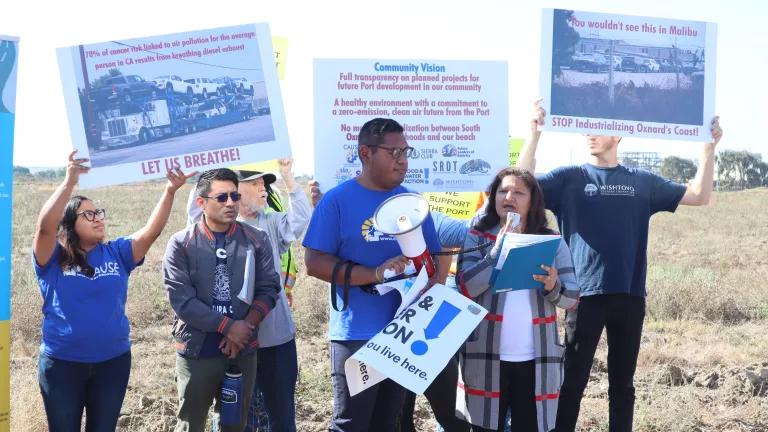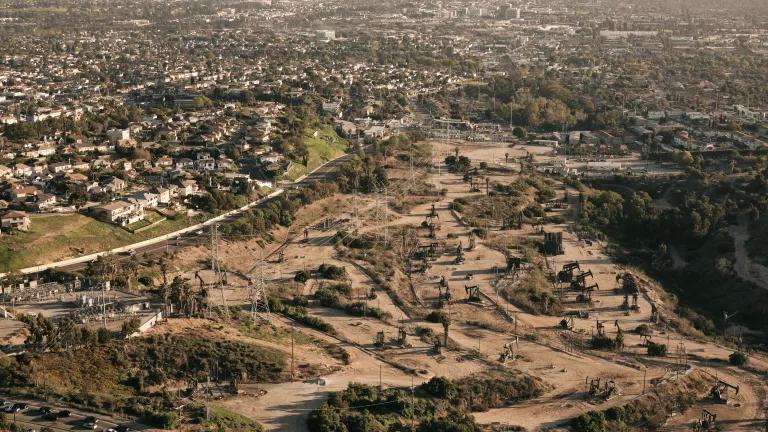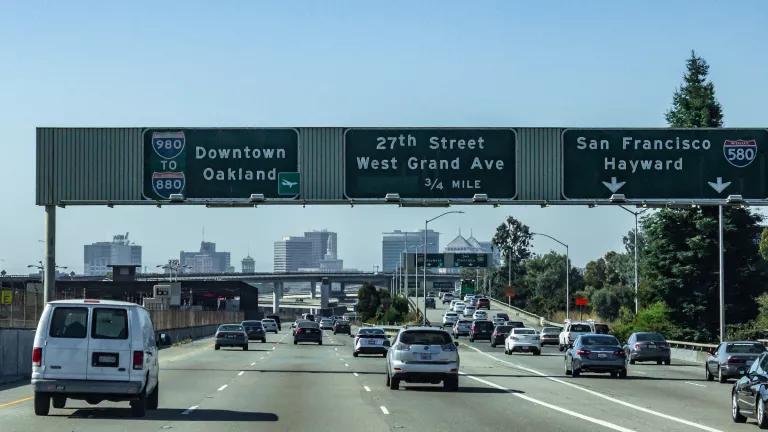Port of LA Revives the Environmentally Unjust SCIG Railyard
Air pollution from SCIG would exacerbate health problems, including asthma rates, cancer rates, and premature deaths, for people who are already overburdened by diesel pollution associated with the nearby San Pedro Bay Ports.

"If you support this project, you are supporting the death of our neighbors."
—Jessica Prieto, an organizer with East Yard Communities for Environmental Justice
Such was the tone at a June 15th zoom hearing, where dozens of residents spoke out against the Southern California International Gateway (SCIG) project. SCIG, a proposed BNSF railyard that would emit toxic air pollution in a community of color in West Long Beach, has recently been revived by the Port of Los Angeles. The renewed project is a textbook case of environmental racism.
If built, SCIG would be located in a neighborhood near schools, senior centers, parks, and residential areas, bringing over a million diesel truck trips and thousands of trains through the community every year. Air pollution from SCIG would exacerbate health problems, including asthma rates, cancer rates, and premature deaths, for people who are already overburdened by diesel pollution associated with the nearby San Pedro Bay Ports.
Community Opposition
This project has already been defeated once. In 2018, the community won a lawsuit which found the environmental review conducted for the SCIG project was inadequate.
But in May 2021, the Port brought the project back from the dead when it released a Revised Draft Environmental Impact Report (RDEIR).
East Yard Communities for Environmental Justice (EYCEJ), Century Villages at Cabrillo, and local advocates have been working for over ten years to uplift frontline community perspectives and voice opposition to the proposed railyard that would bring more pollution to surrounding neighborhoods. At the June hearing, community members expressed their overwhelming opposition to SCIG. Among the themes highlighted in powerful resident testimony that evening included how SCIG would worsen the already severe health impacts facing communities, and the environmental racism behind the proposal to site yet another polluting source in an overburdened community of color.
Why the Port's New Environmental Analysis Is Insufficient
The Port has released a new Revised Draft Environmental Impact Report for SCIG that fails to respond to community concerns and fails to convey an accurate assessment of the project's environmental impacts. Here are five reasons why the new environmental analysis is inadequate.
1. It undermines state and local policies
SCIG would significantly reverse the progress made to establish Los Angeles as an equitable and sustainable city. SCIG is inconsistent with the City’s Green New Deal, which commits to advancing environmental justice for the most overburdened communities, and reducing port related greenhouse gas emissions by 80 percent by 2050. It’s also inconsistent with the commitments set by the Mayor and Port—that have been embraced by Governor Newsom and the California Air Resources Board—to transition to 100% zero-emission drayage trucks by 2035.
2. It fails to consider emission-reducing technologies
The new RDEIR confirms SCIG’s dirty diesel operations will worsen air pollution for neighboring communities. Yet, the RDEIR proposes no new measures to lessen those impacts. The RDEIR fails to consider electrified technologies that could reduce SCIG’s emissions, including zero emission trucks, cargo handling equipment, and locomotives.
3. It relies on out-of-date information
The new RDEIR relies on out-of-date information, making its analyses inaccurate. In particular, the Port analyzes SCIG’s air pollution impacts compared to a 2010 air quality baseline. This analysis fails to account for changes in air quality in the past decade plus, and is insufficient for a project that won’t be operational until 2025 at the earliest.
4. It ignores a decade worth of development
The new RDEIR ignores important developments over the past decade such as the expanding resident population of Century Villages at Cabrillo, a nonprofit homeless services community located directly next to the proposed SCIG site. With plans to build additional housing units, the Village’s proximity to SCIG means that many more people would be negatively impacted if this project were built today, compared to when it was initially proposed. Also, the Ports have made significant recent investments in expanding on-dock rail capacity to handle increased cargo throughput. This undermines the need for SCIG, an additional near-dock railyard that will generate truck pollution.
5. It does not respond to or meet community needs
Residents near the proposed site have clearly expressed that this project is harmful and unwanted in their communities, yet the Port is still trying to build this project. To date, the Port’s public participation process has been inadequate to meaningfully engage the community, as the Port has conducted only one virtual public meeting on the project since the 2021 RDEIR was released. Notably, the Port is trying to move this polluting project forward in the midst of the coronavirus pandemic which has disproportionately wrought harm on communities of color and communities that suffer from elevated levels of air pollution, like those neighboring the SCIG site.
Get Involved
To date, the Port has failed to develop an adequate environmental review for SCIG. If approved, SCIG poses dangerous environmental harms to the communities near the San Pedro Bay Ports that are already overburdened by port-related pollution and other industrial sources. NRDC continues to stand with community members in advocating for LA City officials and the Port of Los Angeles to abandon this toxic project once and for all.
Visit our Action Page to submit a comment on the newly released RDEIR and tell LA City officials to reject the Southern California International Gateway Project and ensure an equitable future for frontline communities.
Thank you to my colleague, Bella Blanco, for contributing to this blog post.
This blog provides general information, not legal advice. If you need legal help, please consult a lawyer in your state.



